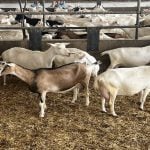TORONTO – Canada needs to put the brakes on livestock producers importing veterinary products for use on their own farms, a conference heard in Toronto in early November.
Known as own-use importation, livestock producers may apply to bring in various pharmaceutical products.
Better controls are needed because some products could be untested, unsafe or contribute to the growing problem of antimicrobial resistance, said the president of the Canadian Animal Health Institute. It represents companies that develop, manufacture and distribute animal health products including pharmaceuticals, biologics, feed additives and animal pesticides in Canada.
Read Also

VIDEO: Agritechnica Day 4: Robots and more robots, Nexat loves Canada and the trouble with tariffs
Agritechnica Day 4: Robots and more robots, Nexat loves Canada and the trouble with tariffs.
“Other countries do not allow, or have such open, liberal policies relative to importation for own-use and particularly relevant to food animals,” said Jean Szkotnicki at a recent Toronto conference discussing prudent antibiotic use.
“These loopholes should be cancelled. Stay tuned, we are still working on it,” she said.
Products can be purchased directly through mail order or through the internet.
Border control officers do not necessarily know what “own use” means and products could end up in the wrong hands.
Sales have probably slowed in recent years because the Canadian currency is on par with the United States. However, these imports continue to represent a sizeable portion of the pharmaceutical trade.
An international 2007 report found imported products were worth about $100 million per year, or about a third of the total value of the licensed Canadian pharmaceutical market.
Producers argue innovation needs to be supported and if red meat is to be competitive they need the same access to the same tools as their competitors. However, some commodities have voluntarily stopped the practice.
For example, the Canadian poultry and pork quality assurance and on-farm food safety programs decided to discourage the use of own-use imports.
Veterinary drugs are not necessarily developed for Canada because it represents only about two percent of the international market. Products are developed in a global context and Canada needs the tools for the licensing of these products, admitted Szkotnicki.
Part of the problem was Canadian rules around limiting sales of cheaper, generic products.
“We had technical requirements that prohibited generics from coming into the marketplace. There are new guidelines for generic drugs and that has meant that we have more generic products in the Canadian market but even generics found it hard to compete against the U.S.,” she said in an interview.
Government knows there is room for improvement and the Veterinary Drugs Directorate within Health Canada is pressing for tighter regulations to ensure antibiotics are only distributed with a prescription.
All newly approved drugs are prescription use only and the directorate plans to extend that requirement for pharmaceuticals approved before 2004, said Manisha Mehrotra of the directorate.
“We do not want a parallel system where there are approved drugs and own-use imports,” Mehrotra said. Quebec is the one province where drugs are only provided by prescription.
Further work is needed to address the problems within the expanding sheep, goat and aquaculture groups. There are few approved products for sheep and fish and none for goats, although veterinarians can provide medications under the extra label provision.
Szkotnicki said these groups need a minor use office funded through the federal Growing Forward program to get specific products approved in Canada.
In the field, prescriptions are not always in place and appropriate measures are not always taken to make sure a particular product is appropriate, said veterinarian Duane Landals.
Nor is anyone sure about the extent these products are used.
Records are not well kept on farms or in vet clinics and not all the products marketed demonstrate good stewardship.
“I can’t say that all products are distributed through appropriate channels,” said Landals, registrar with the Alberta Veterinary Medical Association.
The federal and provincial governments must agree to make the appropriate regulatory changes before an accident happens.
“How do we get to the point where everyone wants to make this change? I hope there is no human health disaster before government acts,” he said.















